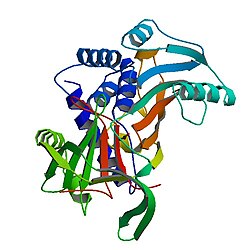SERPINA3
Alpha 1-antichymotrypsin
Protein-coding gene in the species Homo sapiens
Alpha 1-antichymotrypsin (symbol α1AC,[5] A1AC, or a1ACT) is an alpha globulin glycoprotein that is a member of the serpin superfamily. In humans, it is encoded by the SERPINA3 gene.
| SERPINA3 | |||||||||||||||||||||||||||||||||||||||||||||||||||
|---|---|---|---|---|---|---|---|---|---|---|---|---|---|---|---|---|---|---|---|---|---|---|---|---|---|---|---|---|---|---|---|---|---|---|---|---|---|---|---|---|---|---|---|---|---|---|---|---|---|---|---|
 | |||||||||||||||||||||||||||||||||||||||||||||||||||
| |||||||||||||||||||||||||||||||||||||||||||||||||||
| Identifiers | |||||||||||||||||||||||||||||||||||||||||||||||||||
| Aliases | SERPINA3, AACT, ACT, GIG24, GIG25, serpin family A member 3 | ||||||||||||||||||||||||||||||||||||||||||||||||||
| External IDs | OMIM: 107280 MGI: 98377 HomoloGene: 111129 GeneCards: SERPINA3 | ||||||||||||||||||||||||||||||||||||||||||||||||||
| |||||||||||||||||||||||||||||||||||||||||||||||||||
| |||||||||||||||||||||||||||||||||||||||||||||||||||
| |||||||||||||||||||||||||||||||||||||||||||||||||||
| |||||||||||||||||||||||||||||||||||||||||||||||||||
| |||||||||||||||||||||||||||||||||||||||||||||||||||
| Wikidata | |||||||||||||||||||||||||||||||||||||||||||||||||||
| |||||||||||||||||||||||||||||||||||||||||||||||||||
Alpha 1-antichymotrypsin inhibits the activity of certain enzymes called proteases, such as cathepsin G that is found in neutrophils, and chymases found in mast cells, by cleaving them into a different shape or conformation. This activity protects some tissues, such as the lower respiratory tract, from damage caused by proteolytic enzymes.[6]
This protein is produced in the liver, and is an acute phase protein that is induced during inflammation.
Deficiency of this protein has been associated with liver disease. Mutations have been identified in patients with Parkinson disease and chronic obstructive pulmonary disease.[7]
Alpha 1-antichymotrypsin is also associated with the pathogenesis of Alzheimer's disease as it enhances the formation of amyloid-fibrils in this disease.[6]
Alpha 1-antichymotrypsin has been shown to interact with DNAJC1.[8]
- Alpha-1 antitrypsin, another serpin that is analogous for protecting the body from excessive effects of its own inflammatory proteases
- "Human PubMed Reference:". National Center for Biotechnology Information, U.S. National Library of Medicine.
- "Mouse PubMed Reference:". National Center for Biotechnology Information, U.S. National Library of Medicine.
- Logan, Carolynn M.; Rice, M. Katherine (1987). Logan's Medical and Scientific Abbreviations. Philadelphia: J. B. Lippincott Company. p. 3. ISBN 0-397-54589-4.
- Kroczynska B, Evangelista CM, Samant SS, Elguindi EC, Blond SY (March 2004). "The SANT2 domain of the murine tumor cell DnaJ-like protein 1 human homologue interacts with alpha1-antichymotrypsin and kinetically interferes with its serpin inhibitory activity". J. Biol. Chem. 279 (12): 11432–43. doi:10.1074/jbc.M310903200. PMC 1553221. PMID 14668352.
- Janciauskiene S, Wright HT (1999). "Inflammation, antichymotrypsin, and lipid metabolism: autogenic etiology of Alzheimer's disease". BioEssays. 20 (12): 1039–46. doi:10.1002/(SICI)1521-1878(199812)20:12<1039::AID-BIES10>3.0.CO;2-Z. PMID 10048303.
- Kalsheker N, Morley S, Morgan K (2002). "Gene regulation of the serine proteinase inhibitors alpha1-antitrypsin and alpha1-antichymotrypsin". Biochem. Soc. Trans. 30 (2): 93–8. doi:10.1042/BST0300093. PMID 12023832.
- The MEROPS online database for peptidases and their inhibitors: I04.002
- Alpha+1-antichymotrypsin at the U.S. National Library of Medicine Medical Subject Headings (MeSH)
- Human SERPINA3 genome location and SERPINA3 gene details page in the UCSC Genome Browser.
- Overview of all the structural information available in the PDB for UniProt: P01011 (Human Alpha-1-antichymotrypsin) at the PDBe-KB.
This article on a gene on human chromosome 14 is a stub. You can help Wikipedia by expanding it. |




